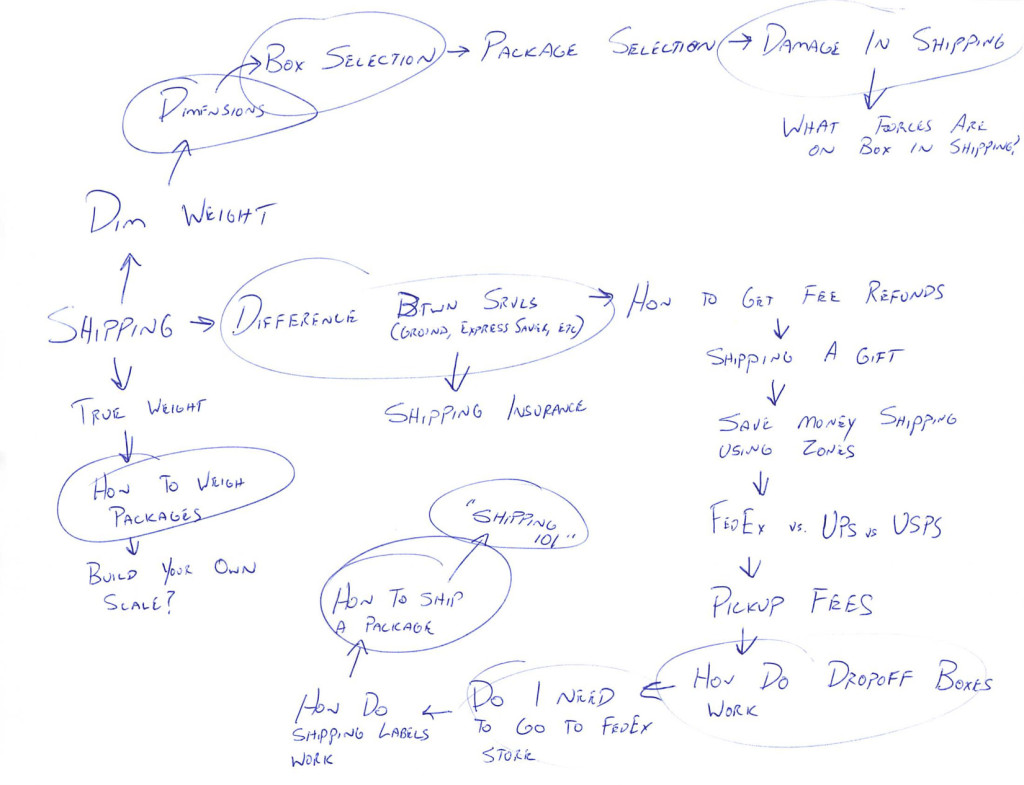Are you someone who relies heavily on logic (as I do), and are looking to improve your creativity? Does it seem out of reach – as though creativity is a birthright and you inherited slam-dunk math skills instead? The good news here is that you’re not stuck in the Left Brain forever – there’s a great logical way to dig into your creative side. It’s one of the strongest skills I’ve honed thus far, and it’s too good not to share – here’s the hack on how the most logical bunch can find their creativity:
The Mind Map
A Mind Map is an incredible tool – I consider it a bridge in my mind between the logical and the creative. It’s simple, it costs $0, and anyone can do it. In order to illustrate the Mind Map effectively, I’ll run through an old Mind Map of my own, where I needed to think of a great blog topic related to shipping.
Step 1: Pull out a piece of blank, unlined paper, and a pen.
I need to emphasize paper – I’ve found that this just doesn’t work as well typing it out, and you’ll find out why soon. I like to use a pen so I don’t have the option to erase ideas.
Step 2: Write down the first word that comes to mind on the left side of the paper.
For my example, I was trying to come up with a blog topic related to shipping, so my first word was “shipping”. Sounds uncreative, right? That’s because it is. It’s incredibly logical, and that’s totally fine. The creative part is easier and more magical than that.
Step 3: Don’t think, and never edit: just keep mapping words.
From that first word, I guarantee you a 2nd word or idea will come to mind almost immediately. For me it was “Dim Weight”, meaning Dimensional Weight. The word or the idea is supremely unimportant – just draw a short arrow off the first word, and write down that next word or thought that comes to mind. After writing the 2nd word/idea (phrases are fine, too), another idea will probably pop into your mind immediately….draw an arrow and write it down. Never edit your thoughts – if you’re thinking about shipping and the word “dog food” comes to mind, then draw an arrow from whatever word led you there, and write “dog food”. There’s no crime in writing it down. I know you’re wondering where the magic in this is, and I promise it’s coming up.
Step 4: Be OK with the slowdown of ideas, and revisit your words
After about 15 – 30 words/ideas, your mind will start to slow down. Those first few ideas are totally rapid fire, as though your mind was aching to let them all out. Now we’re left with some deep ideas that are harder to tease out. The key here will be your lack of editing – if anything comes to mind, no matter how silly or unrelated, you must write it down and draw the link between it and the thought before it. It’s OK to jump back and around – thoughts aren’t linear, so you might have 3 arrows off one word, or might go back to a word to draw an arrow. That’s OK. Once things have slowed down, browse over everything you just wrote – new ideas might pop into your head – write them down. The total process up until this point lasts probably 15 minutes – after that I find your mind is exhausted and done with the whole exercise.
Step 5: Make the connections, and harvest your creative idea.
By now you have a sheet of paper with a couple dozen words and arrows on it and it probably looks a bit….insane. This is the best part, and where the creativity surfaces – you’ve managed to put your entire thought process into a blueprint on paper. You can now look at your thought process on a granular level or as a whole. When you see an idea you like, circle it. Take a few circled ideas, and put them together. You’ll probably end up in a place, with an idea, that is a bit deeper and more insightful than you would have otherwise. For my example, the Mind Map led me to a very simple idea that I actually did not have in mind: “How to Ship a Package”. I know – it sounds absurd. My mind was stuck on this old track of weights, dimensions, fees, billing – but the Mind Map led me to a really cool, and incredibly simple topic that I later went with: “Shipping 101”. I realized I was so focused on the details that I never pay attention to the basics.
Here’s my actual Mind Map from this example:

Wrap up: Why does it work, and what’s the creativity?
The Mind Map starts you on a very simple, logical path – write down everything and draw the links between them. After 15 minutes, through hard work, you’re left with an incredible 3rd person perspective of your own mind. You see ideas and the links between them that you could have never drawn just by sitting quietly and thinking. I picture it like walking across a lake on floating pads: if you sit and just “think”, you’re jumping from thought to thought, only remembering your last 2 or 3. Your thoughts/ideas are your floating pads, and they fall away as you jump from one to the next. When you use a Mind Map they never fall away. You can revisit them and move more freely around the lake – around your mind – and find that hidden idea that we’ve come to label as “creative”, when really it was simply non-obvious.



